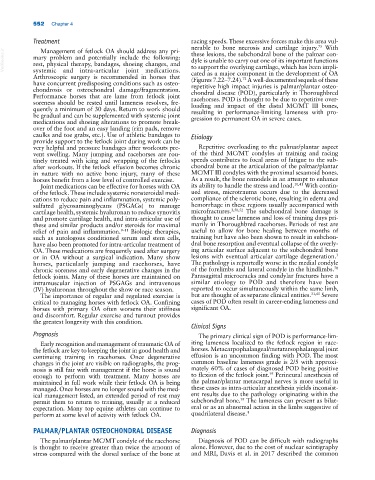Page 586 - Adams and Stashak's Lameness in Horses, 7th Edition
P. 586
552 Chapter 4
Treatment racing speeds. These excessive forces make this area vul-
nerable to bone necrosis and cartilage injury. With
75
Management of fetlock OA should address any pri-
VetBooks.ir mary problem and potentially include the following: dyle is unable to carry out one of its important functions
these lesions, the subchondral bone of the palmar con-
rest, physical therapy, bandages, shoeing changes, and
to support the overlying cartilage, which has been impli-
systemic and intra‐articular joint medications.
Arthroscopic surgery is recommended in horses that cated as a major component in the development of OA
(Figures 7.22–7.24). A well‐documented sequela of these
72
have concurrent predisposing conditions such as osteo- repetitive high impact injuries is palmar/plantar osteo-
chondrosis or osteochondral damage/fragmentation. chondral disease (POD), particularly in Thoroughbred
Performance horses that are lame from fetlock joint racehorses. POD is thought to be due to repetitive over-
soreness should be rested until lameness resolves, fre- loading and impact of the distal MC/MT III bones,
quently a minimum of 30 days. Return to work should resulting in performance‐limiting lameness with pro-
be gradual and can be supplemented with systemic joint gression to permanent OA in severe cases.
medications and shoeing alterations to promote break‐
over of the foot and an easy landing (rim pads, remove
caulks and toe grabs, etc.). Use of athletic bandages to Etiology
provide support to the fetlock joint during work can be
very helpful and pressure bandages after workouts pre- Repetitive overloading to the palmar/plantar aspect
vent swelling. Many jumping and racehorses are rou- of the third MC/MT condyles at training and racing
tinely treated with icing and wrapping of the fetlocks speeds contributes to focal areas of fatigue to the sub-
after workouts. If the fetlock effusion becomes chronic chondral bone at the articulation of the palmar/plantar
in nature with no active bone injury, many of these MC/MT III condyles with the proximal sesamoid bones.
horses benefit from a low level of controlled exercise. As a result, the bone remodels in an attempt to enhance
Joint medications can be effective for horses with OA its ability to handle the stress and load. 10,41 With contin-
of the fetlock. These include systemic nonsteroidal medi- ued stress, microtrauma occurs due to the decreased
cations to reduce pain and inflammation, systemic poly- compliance of the sclerotic bone, resulting in edema and
sulfated glycosaminoglycans (PSGAGs) to manage hemorrhage in these regions usually accompanied with
cartilage health, systemic hyaluronan to reduce synovitis microfractures. 3,50,52 The subchondral bone damage is
and promote cartilage health, and intra‐articular use of thought to cause lameness and loss of training days pri-
these and similar products and/or steroids for maximal marily in Thoroughbred racehorses. Periods of rest are
relief of pain and inflammation. 9–11 Biologic therapies, useful to allow for bone healing between months of
such as autologous conditioned serum and stem cells, training but have also been shown to result in subchon-
have also been promoted for intra‐articular treatment of dral bone resorption and eventual collapse of the overly-
OA. These medications are frequently used after surgery ing articular surface adjacent to the subchondral bone
3
or in OA without a surgical indication. Many show lesions with eventual articular cartilage degeneration.
horses, particularly jumping and racehorses, have The pathology is reportedly worse in the medial condyle
70
chronic soreness and early degenerative changes in the of the forelimbs and lateral condyle in the hindlimbs.
fetlock joints. Many of these horses are maintained on Parasagittal microcracks and condylar fractures have a
intramuscular injection of PSGAGs and intravenous similar etiology to POD and therefore have been
(IV) hyaluronan throughout the show or race season. reported to occur simultaneously within the same limb,
The importance of regular and regulated exercise is but are thought of as separate clinical entities. 31,45 Severe
critical to managing horses with fetlock OA. Confining cases of POD often result in career‐ending lameness and
horses with primary OA often worsens their stiffness significant OA.
and discomfort. Regular exercise and turnout provides
the greatest longevity with this condition.
Clinical Signs
Prognosis The primary clinical sign of POD is performance‐lim-
Early recognition and management of traumatic OA of iting lameness localized to the fetlock region in race-
the fetlock are key to keeping the joint in good health and horses. Metacarpophalangeal/metatarsophalangeal joint
continuing training in racehorses. Once degenerative effusion is an uncommon finding with POD. The most
changes in the joint are visible on radiographs, the prog- common baseline lameness grade is 2/5 with approxi-
nosis is still fair with management if the horse is sound mately 60% of cases of diagnosed POD being positive
95
enough to perform with treatment. Many horses are to flexion of the fetlock joint. Perineural anesthesia of
maintained in full work while their fetlock OA is being the palmar/plantar metacarpal nerves is more useful in
managed. Once horses are no longer sound with the med- these cases as intra‐articular anesthesia yields inconsist-
ical management listed, an extended period of rest may ent results due to the pathology originating within the
95
permit them to return to training, usually at a reduced subchondral bone. The lameness can present as bilat-
expectation. Many top equine athletes can continue to eral or as an abnormal action in the limbs suggestive of
perform at some level of activity with fetlock OA. quadrilateral disease. 4
PALMAR/PLANTAR OSTEOCHONDRAL DISEASE Diagnosis
The palmar/plantar MC/MT condyle of the racehorse Diagnosis of POD can be difficult with radiographs
is thought to receive greater than twice the amount of alone. However, due to the cost of nuclear scintigraphy
stress compared with the dorsal surface of the bone at and MRI, Davis et al. in 2017 described the common

